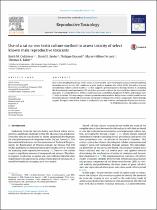| dc.contributor.author | Goldstein, Keith M. | |
| dc.contributor.author | Seyler, David E. | |
| dc.contributor.author | Baker, Thomas K. | |
| dc.date.accessioned | 2023-04-13T10:19:14Z | |
| dc.date.available | 2023-04-13T10:19:14Z | |
| dc.date.issued | 2016 | |
| dc.identifier.citation | Goldstein, K. M. et al. (2016). Use of a rat ex-vivo testis culture method to assess toxicity of select known male reproductive toxicants. Reproductive Toxicology, 60, 92-103. https://doi.org/10.1016/j.reprotox.2016.01.003 | en_US |
| dc.identifier.issn | 0890-6238 | |
| dc.identifier.uri | https://doi.org/10.1016/j.reprotox.2016.01.003 | |
| dc.identifier.uri | http://hdl.handle.net/10566/8778 | |
| dc.description.abstract | Due to the complex physiology of the testes, in vitro models have been largely unsuccessful at modeling testicular toxicity in vivo. We conducted a pilot study to evaluate the utility of the Durand ex vivo rat seminiferous tubule culture model [1], [2], [3] that supports spermatogenesis through meiosis II, including the formation of round spermatids. We used this system to evaluate the toxicity of four known testicular toxicants: 1,3-dinitrobenzene (DNB), 2-methoxyacetic acid (MAA), bisphenol A (BPA), and lindane over 21 days of culture. | en_US |
| dc.language.iso | en | en_US |
| dc.publisher | Elsevier | en_US |
| dc.subject | Dinitrobenzene | en_US |
| dc.subject | Methoxyacetic | en_US |
| dc.subject | Testicular toxicity | en_US |
| dc.subject | Bioscience | en_US |
| dc.title | Use of a rat ex-vivo testis culture method to assess toxicity of select known male reproductive toxicants | en_US |
| dc.type | Article | en_US |

